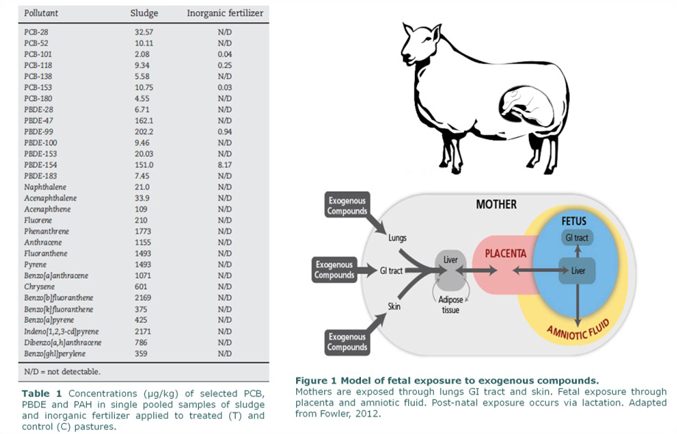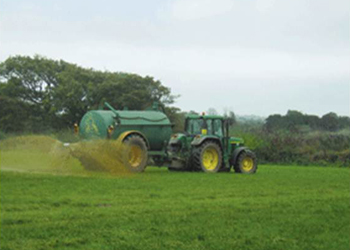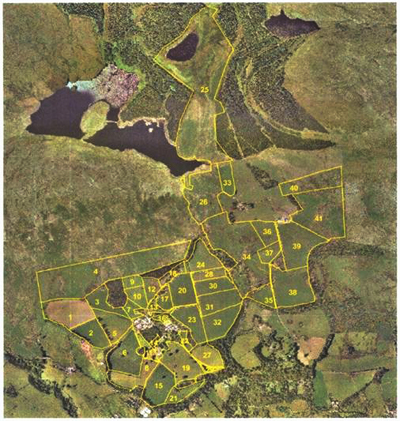Sewage sludge application to pasture as a model to study the effects of pollutant exposure on animal and ecosystem health
Background
Soil supports a range of ecosystem services that underpin the sustainability of our production systems and environmental security. The recycling of treated waste-water (sewage sludge) by applying it to land as a soil conditioner and source of nutrients is a regulated agricultural procedure which has long been practised. Sewage sludge (from wastewater treatment) contains a complex mixture of environmental chemicals and heavy metals (Table 1) some of which have been shown to have endocrine disrupting effects.

Sludge application to pasture therefore represents a relevant model of both maternal and fetal exposure to exogenous endocrine disrupting chemicals (EDCs, Figure 1). There are concerns that if inappropriate rates of application are used and/or the material also introduces excess nutrients and potentially toxic chemicals into an ecosystem, that this could have long term effects on ecosystem services, biodiversity and animal health.
In 1994 as part of the Long Term Sludge Experiment (LTSE) to examine the long term effects of sludge application on agricultural land, sewage sludge treated experimental field sites were established by the James Hutton Institute at Hartwood, North Lanarkshire.
 In 2007, as part of a large Wellcome Trust grant in collaboration with JHI (Dr Stewart Rhind), University of Aberdeen (Prof Paul Fowler), University of Edinburgh (Prof Richard Sharpe), INRA, France (Dr Corinne Cotinot), University of Nottingham (Prof Richard Lea), Dr Bellingham and Prof Evans from the University of Glasgow began to study the physiological effects of exposure to sludge treated pastures via grazing, in sheep.
In 2007, as part of a large Wellcome Trust grant in collaboration with JHI (Dr Stewart Rhind), University of Aberdeen (Prof Paul Fowler), University of Edinburgh (Prof Richard Sharpe), INRA, France (Dr Corinne Cotinot), University of Nottingham (Prof Richard Lea), Dr Bellingham and Prof Evans from the University of Glasgow began to study the physiological effects of exposure to sludge treated pastures via grazing, in sheep.
Dr Bellingham and Prof Evans have published a number of papers documenting the effects of exposure to sewage sludge chemicals on the reproductive system in sheep, and together the group have published several papers showing the effects of sludge exposure on several other body systems and behaviour (see publications) in sheep.
The study system
 To extend previous studies using the sewage sludge model, Dr Bellingham, with support from University of Glasgow Cochno Research Farm director Dr Peter Hastie, has recently established additional sludge treated experimental sites to further study the physiological effects of chemical exposure on other species and wild animal populations.
To extend previous studies using the sewage sludge model, Dr Bellingham, with support from University of Glasgow Cochno Research Farm director Dr Peter Hastie, has recently established additional sludge treated experimental sites to further study the physiological effects of chemical exposure on other species and wild animal populations.
Cochno Research Farm occupies a total area of 230.62 Ha incorporating various rural environments at different altitudes (Figure 2). In August 2014, thermally dried sludge pellets were applied to 60.74 Ha of this agricultural land at Cochno (in accordance with regulations, at conventional rates), with further applications due from April 2015 onwards. Previous studies from Rhind et al (2013) have shown that a single application of sludge is sufficient to increase soil chemical levels.
Research application
While the sludge treated pastures at Cochno will host further animal exposure experiments, recent installation of bird nest boxes in the areas surrounding sludge treated pastures has initiated new collaborations to study birds which forage in these polluted areas (in collaboration with Dr Barbara Helm).
However, the unique nature of this resource in terms of the range of different environments and habitats directly exposed to sewage sludge, or in the vicinity of this exposure, offers great potential to address other important ecological questions pertaining to the effects of chemical exposure on populations ecology and ecosystem health which are currently lacking.
Contacts
Dr Michelle Bellingham (Michelle.Bellingham@glasgow.ac.uk) 0141 330 5725
Prof Neil Evans (Neil.Evans@glasgow.ac.uk) 0141 330 5975
Dr Peter Hastie, Cochno Research Farm, (Peter.Hastie@glasgow.ac.uk) 0141 330 1902
Selected publications
- N. P. Evans, M. Bellingham, R. M. Sharpe, C. Cotinot, S. M. Rhind, C. Kyle, H. Erhard, S. Hombach-Klonisch, P. M. Lind, and P. A. Fowler (2014). Does grazing on biosolids treated pasture pose a pathophysiological risk associated with increased exposure to endocrine disrupting compounds? Journal of Animal Science J Anim Sci. Aug;92(8):3185-98. doi: 10.2527/jas.2014-7763. Epub 2014 Jun 19.
- M. Bellingham, M.R. Amezaga, B. Mandon-Pepin, C.J.B. Speers, C.E. Kyle, N.P. Evans, R.M. Sharpe, C. Cotinot, S.M. Rhind and P.A. Fowler (2013). Exposure to chemical cocktails before or after conception - the effect of timing on ovarian development. Mol Cell Endocrinol. 376(1-2):156-72.
- S. Hombach-Klonisch, A. Danescu, F. Begum, M.R. Amezaga, S.M. Rhind, R.M. Sharpe, N.P. Evans, M Bellingham, C. Cotinot, B. Mandon-Pepin, P.A. Fowler, T. Klonisch (2013). Peri-conceptional changes in maternal exposure to sewage sludge chemicals disturbs fetal thyroid gland development in sheep. Mol Cell Endocrinol. 367(1-2):98-108.
- Rhind SM, Kyle CE, Ruffie H, Calmettes E, Osprey M, Zhang ZL, Hamilton D, McKenzie C. Short- and long-term temporal changes in soil concentrations of selected endocrine disrupting compounds (EDCs) following single or multiple applications of sewage sludge to pastures. Environ Pollut. 2013 Oct;181:262-70. doi: 10.1016/j.envpol.2013.06.011. Epub 2013 Jul 27.
- M. Bellingham, C. McKinnell, P.A. Fowler, M.R. Amezaga, S.M. Rhind, Z.L. Zhang, C. Cotinot, B. Mandon-Pepin, N.P. Evans and R.M Sharpe (2012). Fetal and post-natal exposure to sewage sludge chemicals disrupts adult sperm production in a subset of animals. Int J Androl. 35:317-29.
- S.M Rhind, C.E Kyle, C. Mackie, L. McDonald, Z. Zhang, E.I Duff, M. Bellingham, M.R Amezaga, B. Mandon-Pepin, B. Loup, C. Cotinot, N.P Evans, R.M Sharpe, P.A Fowler. (2010) Maternal and fetal tissue accumulation of selected endocrine disrupting compounds (EDCs) following exposure to sewage sludge-treated pastures before or after conception. J. Environ. Monit 12(8):1582-93
- M. Bellingham, P.A. Fowler, M.R. Amezaga, C.M. Whitelaw, S.M. Rhind, C. Cotinot, B. Mandon-Pepin, R.M. Sharpe and N.P. Evans (2010). Foetal Hypothalamic and Pituitary Expression of GnRH and Galanin Systems is Disturbed by Exposure to Sewage Sludge Chemicals via Maternal Ingestion. J. Neuroendocrinol 22:527-533
- M. Bellingham, P. A. Fowler, M. R. Amezaga, S.M. Rhind, C. Cotinot, B. Mandon-Pepin, R. M. Sharpe, C. E. Kyle and N. P. Evans (2009). Exposure to a complex cocktail of environmental endocrine disrupting compounds present in sewage sludge disturbs the KiSS-1/GPR54 system in ovine hypothalamus and pituitary gland. Environ. Health Perspect. 117(10):1556-62.
News archives
- University of Glasgow press release: Study suggest chemicals in the environment could threaten male fertility
- BBC News (May 2012): Chemicals in environment 'damaging male fertility'
- STV News (May 2012): Chemicals found in cosmetics and detergents 'could threaten male fertility'

